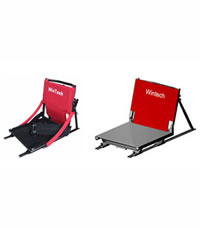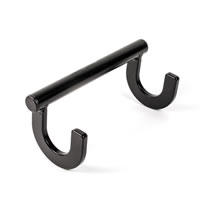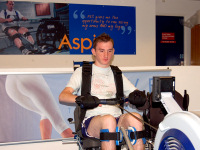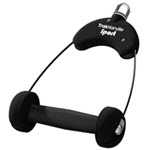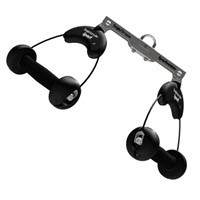What are Intervals?
An interval workout consists of bouts of high intensity work alternating with periods of lower intensity or rest. By varying the length of the work interval and the length of the rest interval, a wide variety of workouts can be designed to achieve a range of goals. Here are some common questions about intervals
Interval Q and A
Q. Intervals are only important for competitive athletes, right?
A. Wrong!
It is true that intervals are an important training component for anyone preparing for competition.
They help you:
- Learn to compete with greater intensity.
- Build the time that you can maintain a certain level of intensity.
- Improve your speed of recovery.
- Develop your body’s ability to switch between energy systems.
And they are a very time-efficient method of achieving all these goals. But recent research is showing that intervals are not just for competitive athletes.
Q. Can intervals help me lose weight and maintain health?
A. Yes. Research suggests that interval training may be a very time-efficient and effective way to lose weight, not to mention that it will build your fitness as effectively as longer, moderate workouts.
A study in Japan reached the intriguing conclusion that you would burn more fat with two 30 minutes bouts of exercise separated by a 20 minute rest period than in a single 60 minute session.
And finally, intervals add variety and structure to your workouts, which makes them even more interesting and helps the time pass.
Q. Why are intervals good for older athletes?
A. They have been shown to be the most effective workout for stemming the tide of aging.
A pilot study in Norway has shown that interval workouts may be more effective than longer, lower intensity workouts for reducing cholesterol, adjusting the ratio of fatty acids in the blood, and reducing the risk factors for metabolic syndrome. They have also been shown to be an effective therapy for patients with heart failure. Consult with your physician before starting an exercise program.
Q. Then why not do them all the time?
A. Because you can’t. Expect to be tired after doing intervals. If you’re not, you’re not doing them hard enough. You need to allow your body to recover for a day or two after interval sessions. Competitive athletes might do intervals as many as five days per week during a high-intensity speed training week; older athletes can generally do intervals up to 2–3 times per week.
Q. What should I know before I get started?
A. Warm up well.
The reason intervals are so effective is that they are intense. By working intensely, even for a short period of time, you place a greater demand on your heart and lungs, which in turn provides a stronger stimulus for physiological change. If all of your exercise is at the same moderate level, it will still burn Calories, but it won’t inspire your body to make changes. In order to work at a higher intensity, it is even more important warm-up well and be sure you are using proper technique. We recommend at least 10 minutes of warm-up.
Favorite Intervals from Concept2
Before trying these workouts, please read our liability disclaimer.
Meredith, Concept2 Team: Marketing
Favorite interval workout: Pyramid intervals. Start with 100m, then 200m, then 300m on up to 1000m and then back down, with 1 minute rest in between. It will take approximately one hour.
Variations: Shorten the workout by lowering the top of the pyramid.
Benefits: Pyramid intervals keep the workout interesting, and on the way back down it’s psychologically easier at high intensity because the intervals are getting shorter!
Dick, Concept2 Team: Engineering (and co-founder)
Favorite interval workout: 30 seconds of rest every 3 minutes. Pre-set the PM for a 2:30 work interval and a 0:30 rest interval. Aim for 30 minutes total time (10 work intervals).
Variations: Make the intervals a little easier but shorten the rest to 20 seconds. You can also choose to do either fewer intervals, or more!
Benefits: The short breaks allow you a brief mental and physical recovery without letting the heart rate drop very much. The end result is a sustained high quality aerobic workout.
Bruce, Concept2 Team: Leadership Team
Favorite interval workout: 6 repetitions of 500 meters of work with 1:45 rest, making each interval faster than the one before.
Variations: Choose to do 4 or 5 of these intervals, and you can opt to extend the rest length to 2 minutes.
Benefits: This is a classic interval workout that prepares you well for the 2000 meter race.
Peter, Concept2 Team: Engineering (and co-founder)
Favorite interval workout: 500m, 1 minute rest, 1000m, 2 minute rest, 1500m, 3 minute rest, 1000m, 2 minute rest, 500m, 1 minute rest, 250m. Go at your 2k target pace for the first three intervals, then faster for the last three.
Benefits: This is good preparation for a 2000 meter race because it helps you get familiar with your race pace on the way up the pyramid, and then pushes your intensity limits on the way back down. It’s also a great one to do when you don’t feel like working out.
Judy, Concept2 Team: Marketing
Favorite interval workout: 4 x 4 minutes with 2 minutes rest. Do the first interval at about 80% effort until you get to the last 30 seconds, then up the intensity. Start at 85% for the next two intervals, again increasing the intensity in the last 30 seconds. On the last one, start at 85% and build the intensity through the last minute.
Variations: Start with just three intervals, and increase to five or six if you can.
Benefits: These are very effective at building aerobic capacity.
CrossFit Tabata Intervals
The Tabata interval workout gets its name from Tzumi Tabata who demonstrated its effectiveness in 1996. His study compared two 6-week workout regimens:
- An hour of steady moderate work five times a week.
- 7–8 repetitions of a 20 second work interval at very high intensity followed by 10 seconds of rest, also five days per week.
He found that the interval workout resulted in a greater improvement in the VO2max, a key measure of aerobic fitness—14% vs. 9.5%. Moreover, the interval workout also improved anaerobic capacity by a very significant 28%, while the steady work had no measurable effect.
The bottom line: Tabata intervals are a very time-efficient way to get a terrific workout. On those days when you don’t have time to work out, try a quick round of Tabatas. You can set them up as a Favorite on your PM. Just be sure to get a solid warm-up before you start.
Note: We thank the CrossFit community for introducing us to the power of Tabata intervals. Tabatas are a key component of the CrossFit regimen. For more information about CrossFit, visit crossfit.com.
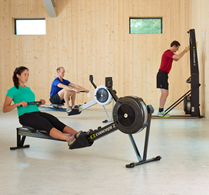



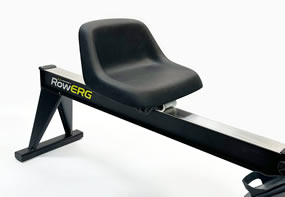 The Concept2 Tractor Seat is an after-factory alternative sliding seat available for Concept2 Indoor Rowers Models A, B, C, D, and E. It features:
The Concept2 Tractor Seat is an after-factory alternative sliding seat available for Concept2 Indoor Rowers Models A, B, C, D, and E. It features: